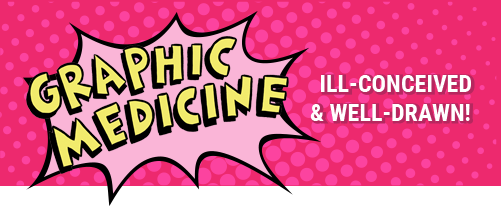Class 6: The Medical Students’ Experience
Introduction:
This class explores the transformation that takes place as students become physicians or other health professionals. Focusing on the medical school experience, comics created by medical students offer insights into that describe what it is like to be immersed in the medical culture. How do students’ identities change over time? How do they view their colleagues and mentors? What does it say about the culture of medicine that students often feel neglected and mistreated?
The Taming of Tina explores the biases and assumptions medical students may have about taking care of challenging patients. Whatever Floats Your Boat reflects how one student changed during his medical education. HMC Safari Adventure depicts doctors as wild animals, with specialists represented by different species. Code Blue illustrates the first time a student witnesses a patient’s death. In Art of Darkness, George and Green reveal some of the negative perceptions that students have of mentors and teachers. And in “Comics and Medicine” Green discusses how having students create comics can reveal the process by which they develop their professional identities.
A class activity involves having students draw various health care providers using the Nine-Panel Template.
Class Resources
- Olmsted, Taylor. “The Taming of Tina.” 2012. https://sites.psu.edu/graphicnarratives/files/2016/08/Taylor-Olmsted-FINAL-for-web-1cb6gc7.pdf
- Lavin, Shane. “Whatever Floats Your Boat.” 2014. http://sites.psu.edu/graphicnarratives/wp-content/uploads/sites/58355/2016/08/Shane-Lavin.pdf
- Natter, Michael. “Annals Graphic Medicine - Code Blue.” Annals of Internal Medicine April 4, 2017. http://annals.org/aim/article/2614102/annals-graphic-medicine-code-blue
- Whyte, Noelle. “HMC Safari Adventure.” 2013. http://sites.psu.edu/graphicnarratives/wp-content/uploads/sites/58355/2016/08/Whyte.pdf
- George, D. R. and Michael J. Green. “Lessons Learned From Comics Produced by Medical Students: Art of Darkness.” JAMA December 8, 2015; 314(22):2345–2346. doi: 10.1001/jama.2015.13652. [PubMed]
- Green, Michael J. “Comics and Medicine: Peering into the Process of Professional Identity Formation.” Academic Medicine June 2015; 90(6):774–9. doi: 10.1097/ACM.0000000000000703. [PubMed]
Discussion Questions
- What do the medical students’ comics illuminate about the culture of medicine?
- Is it necessary to make personal sacrifices to become a doctor? What do the comics reveal about the things students give up to pursue their training?
- Medical students sometimes depict their mentors as monsters. What do you think the monster metaphor represents?
- We often are told to avoid stereotypes when describing people who are part of groups. Is there a positive value to these representations? Discuss the pros and cons, as well as what we can learn from stereotypes employed by medical students to describe their profession.
- Discuss daily diary entries as a class.
- If students are comfortable doing so, have volunteers read their diary entries for the week while the other students listen and draw something they heard on 4 x 6 index cards. Invite several different people read their diary entries, and then have the students walk around the room and take a look at the images people drew from what they heard.
- How did the activity affect the way you observed your surroundings?
- What did you hear that was surprising?
- Do you remember seeing or hearing things that you wouldn’t have noticed if you hadn’t been assigned this diary?
- Other thoughts about the daily diary?






